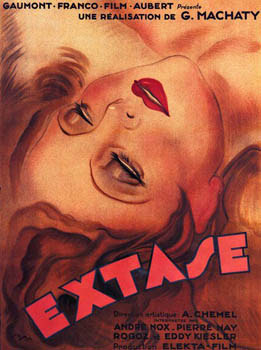Not Hedley but HEDY Lamarr: Screen Siren and Science Whiz
 French poster for "Ecstasy"
French poster for "Ecstasy"Hedy Lamarr? I’ve never seen Ecstasy,the 1933 Czech film (with certain similarities to Lady Chatterley’s Lover)in which she swam naked and allowed her face to suggest the joys of an orgasmicencounter. The film of course met resistance in many nations, including theU.S., where it was denied the seal of the all-important Hays office. That’s whyits American release was limited to a few independent art houses.
Back then Lamarr was stillbilled as Hedy Kiesler, the name with which she was born in 1914 Vienna. Theonly child of Jewish parents (though her mother apparently adopted Christianityearly on), she quickly showed she had brains as well as beauty. Her father, whoadored her, enjoyed talking to young Hedy about technology. But once shedeveloped a passion for acting, she devoted her energies to advancing her stageand screen career. At 18, while playing the youthful Empress Elisabeth in ahighly regarded Vienna theatre production, she attracted scores of admirers.One was 33-year-old Friedrich Mandl, a hugely wealthy munitions manufacturerwith close ties to Mussolini and later to Hitler.
Why exactly did she marry thisdomineering man, who made her give up her acting career in order to play thepart of a dutiful wife? A 2019 historical novel, Marie Benedict’s The OnlyWoman in the Room, claims her father encouraged her in the marriage, as away of potentially saving herself and her family from a rising tide of anti-Semitism. I have no faith in Benedict as an in-depth researcher, but shealso posits that much of Lamarr’s later life in Hollywood was marked by herguilt over the fact that she was aware of, but had no way to stop, Hitler’smurderous plot against Europe’s Jews.
But the marriage itself soonturned dangerous, with Hedy being treated by her spouse as a prisoner in herown home (by which I mean a castle or two). She escaped to England, where she quickly cozied up to Louis B. Mayer,who was abroad looking for new talent. It was he and his MGM colleagues whogave her a new last name, promoted her as the “world’s most beautiful woman,”and starred her in exotic vehicles like 1938’s Algiers with CharlesBoyer. The role of an exotic seductress became her specialty, in films such as WhiteCargo (1942) and Samson and Delilah (1949).
The most unlikely aspect ofLamarr’s biography is the fact that, at the height of World War II, she joinedwith avant-garde composer George Antheil to support the anti-Nazi cause bydeveloping a radio guidance system for Allied torpedoes. Her invention, whichwas patented but never accepted by the U.S. military, “used spreadspectrum and frequency-hoppingtechnology to defeat the threat of jammingby the Axis powers.” (I’m quoting here from the evcr-usefulWikipedia, but I have no idea what I’m saying.) Apparently their discovery has now contributed hugely to the rise ofcellphones, so I’m not sure if we should be grateful or not.
Meanwhile, as an Americanmovie star of the Golden Age, Lamarr accepted the fact that her main functionwas to be beautiful. Though her invention didn’t help win the war, she sold awhole lot of war bonds by guaranteeing to kiss young soldiers if enough money wasraised on the spot. But personal happiness remained elusive. After six failed marriages, she lived most ofher later life in seclusion. One oddity: her 1976 lawsuit claiming that thecomic use of the name Hedley Lamarr for Harvey Korman’s character in MelBrooks’ Blazing Saddles violated her right of privacy.

Beverly in Movieland
- Beverly Gray's profile
- 10 followers



